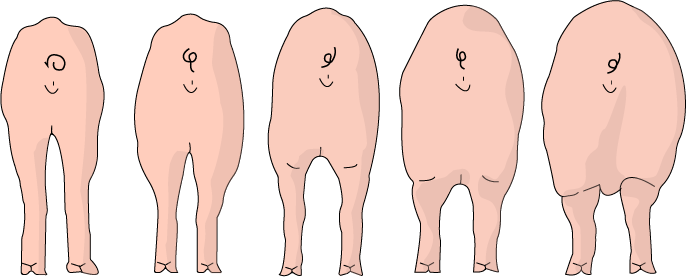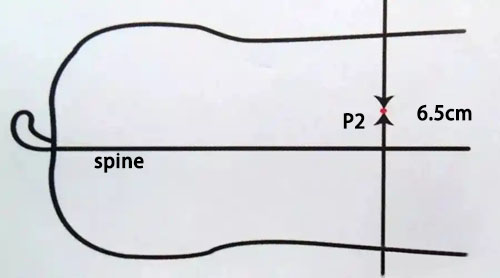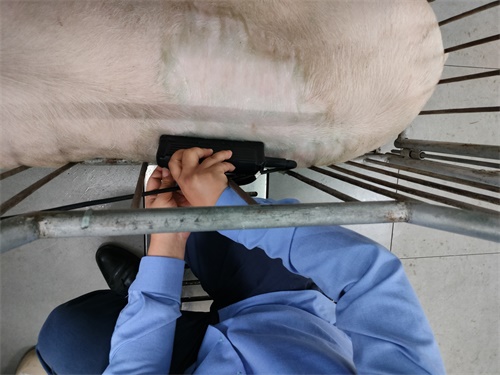Backfat thickness in sows is a critical indicator of body condition and overall reproductive and metabolic health. Accurate measurement of backfat provides essential data for optimizing nutrition, managing reproduction, and improving herd longevity and productivity. Various methods have been developed for backfat evaluation in commercial pig production, ranging from manual palpation to advanced ultrasonographic imaging. This article outlines the major methods used to assess backfat in sows, their advantages, limitations, and practical applications in modern pig farming.

1. Importance of Measuring Backfat in Sows
Backfat in sows serves as a proxy for energy reserves. Monitoring these reserves is particularly important at key stages such as breeding, farrowing, and weaning. Both excessive and insufficient backfat can have detrimental effects:
-
Too much backfat increases the risk of farrowing complications, leg weakness, and reduced lactation performance.
-
Too little backfat can lead to lower reproductive efficiency, longer weaning-to-estrus intervals, and shorter sow longevity.
Therefore, backfat assessment is an integral component of sow management and is often included in herd health and breeding protocols.
2. Manual Palpation and Visual Scoring
Historically, producers relied on manual palpation and visual scoring to assess backfat thickness. This method involves evaluating the fat coverage over the loin and spine using the fingers and assigning a body condition score (BCS), typically on a scale from 1 (very thin) to 5 (very fat).
Advantages:
-
Simple, fast, and cost-effective.
-
No equipment required.
Limitations:
-
Highly subjective and dependent on the evaluator’s experience.
-
Poor reproducibility and limited sensitivity to small changes.
-
Not suitable for research or precision management.
As precision farming becomes more widespread, reliance on subjective scoring alone is increasingly considered insufficient.

3. Backfat Calipers
Some farms use backfat calipers, which are mechanical devices that measure the depth of fat by assessing skinfold thickness over standard anatomical landmarks such as the P2 position (approximately 6.5 cm from the midline at the last rib).
Advantages:
-
More consistent than palpation.
-
Inexpensive and portable.
Limitations:
-
Still subject to operator error.
-
Measures may be affected by skin thickness or sow movement.
-
Accuracy diminishes in animals with excessive fat or loose skin.
Backfat calipers serve as a step up from visual methods, though they are rarely used in high-precision operations.
4. Ultrasonography (Ultrasound Imaging)
Ultrasonography is the gold standard for backfat measurement in sows, offering accuracy, reproducibility, and non-invasive assessment. It uses high-frequency sound waves to measure tissue thickness at precise anatomical locations.
Technique:
-
A 5–7.5 MHz linear transducer is typically used.
-
Measurement is taken at standardized points: the most common is the P2 site, located 6.5 cm off the midline at the level of the last rib.
-
Ultrasound gel is applied to ensure good contact between the probe and the skin.
-
Images show clear differentiation between skin, fat, and muscle layers.
Advantages:
-
Objective, repeatable, and accurate.
-
Allows for digital storage and remote evaluation.
-
Enables longitudinal monitoring over time.
Limitations:
-
Requires training and practice.
-
Equipment cost may be high for small farms.
-
Environmental conditions (e.g., mud, temperature) may interfere with scanning.
Despite these challenges, ultrasound is now widely adopted in genetic programs, research studies, and commercial production systems aiming for high efficiency.

5. Automatic Ultrasonic Backfat Scanners
With the advancement of technology, portable, automatic backfat scanners have been developed. These digital devices connect to tablets or smartphones and provide real-time backfat readings, reducing human error.
Benefits:
-
Improved consistency across users.
-
Integration with herd management software.
-
Fast data processing and record keeping.
These systems represent the future of precision livestock farming, particularly when integrated with artificial intelligence and genetic selection software.
6. Interpreting and Applying Backfat Data
Target Ranges:
-
Gilts at mating: 16–20 mm.
-
Sows at farrowing: 18–22 mm.
-
Sows at weaning: Minimum 14–16 mm.
Excessive backfat loss (>4 mm during lactation) is associated with poor post-weaning performance. Accurate backfat measurement allows producers to:
-
Adjust feed rations for specific individuals.
-
Evaluate genetic lines for feed efficiency.
-
Monitor the impact of nutritional or management interventions.
-
Optimize culling and replacement strategies.
7. Choosing the Right Method
The ideal method for measuring backfat depends on farm goals, resources, and scale of operation. Here’s a comparison:
| Method | Accuracy | Cost | Skill Required | Suitability |
|---|---|---|---|---|
| Palpation & BCS | Low | Low | Moderate | Small farms |
| Backfat Calipers | Moderate | Low | Moderate | Hobby farms |
| Ultrasonography | High | Medium–High | High | Commercial farms |
| Auto Ultrasonic Scanners | Very High | High | Low–Medium | Precision farms |
8. Conclusion
Monitoring sow backfat is a fundamental component of modern swine management. While traditional methods still have value, especially in low-resource settings, ultrasound-based techniques offer unparalleled precision and actionable insights. As swine production becomes more data-driven, integrating reliable backfat assessment tools into routine herd management will be essential for maximizing productivity, profitability, and animal welfare.

References
-
National Pork Board. “Backfat Measurement and Body Condition Scoring.”
https://www.pork.org/research/backfat-measurement-and-body-condition-scoring/ -
PIC Genetic Guidelines. “Using Ultrasound for Sow Condition Management.”
https://na.picgenus.com/resources/ultrasound-and-body-condition/ -
Iowa State University Extension. “Swine Body Condition Scoring System.”
https://www.extension.iastate.edu -
Merck Veterinary Manual. “Swine Management and Production.”
https://www.merckvetmanual.com/management-and-nutrition/swine